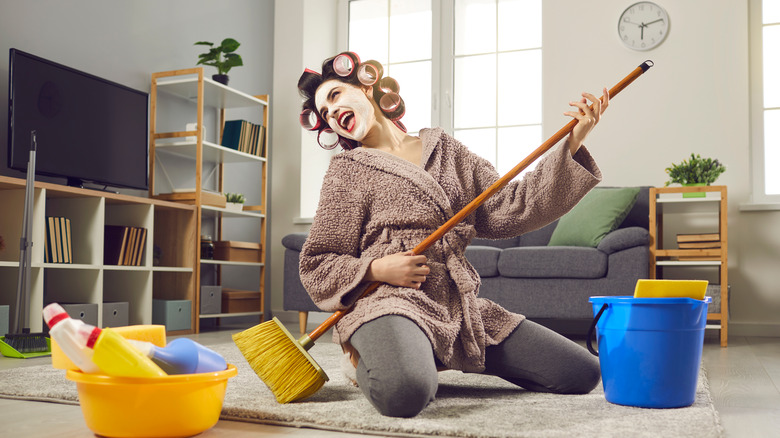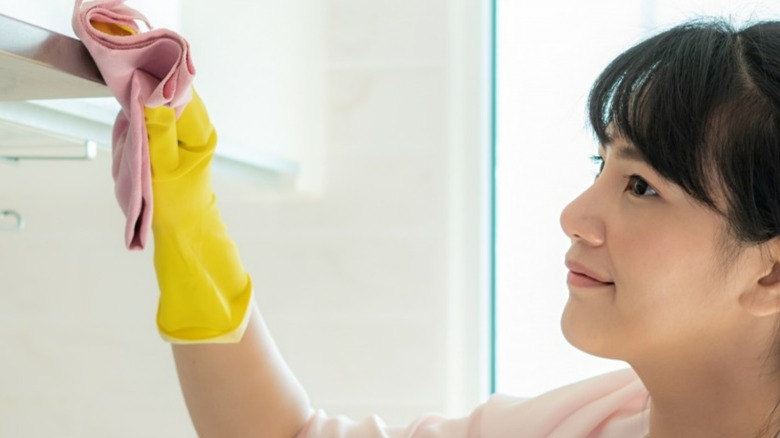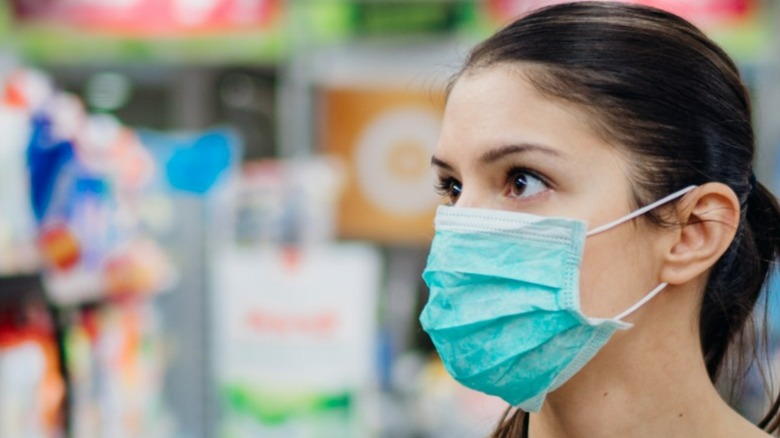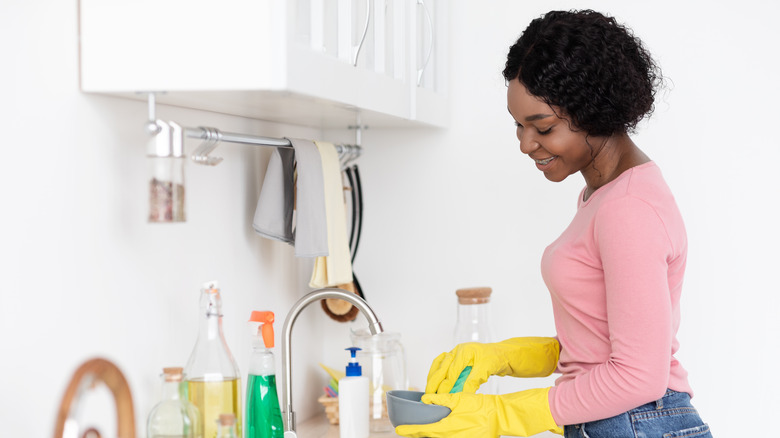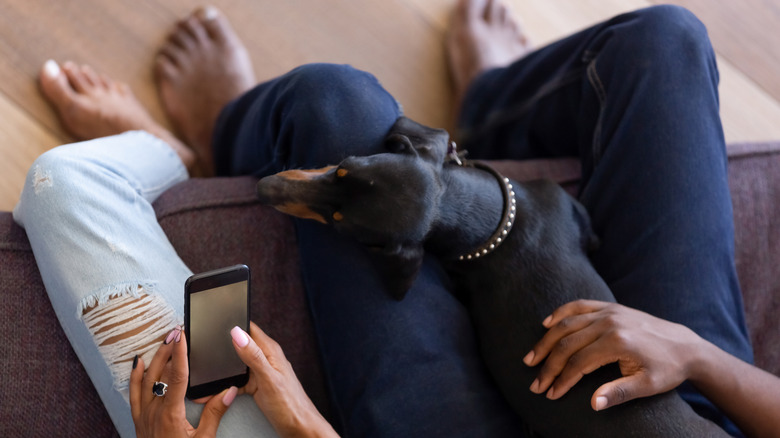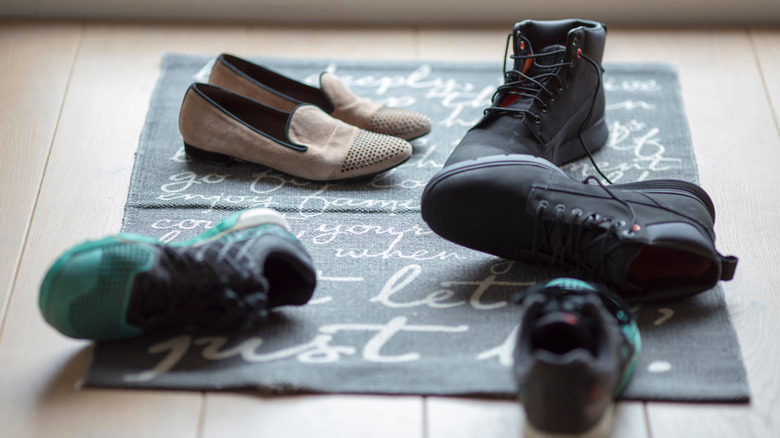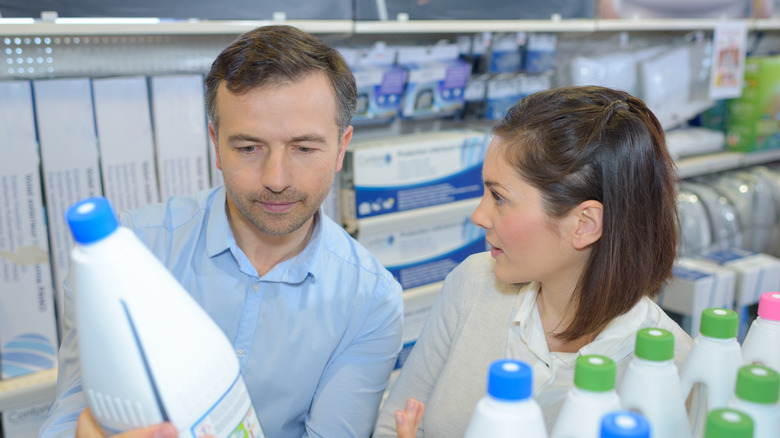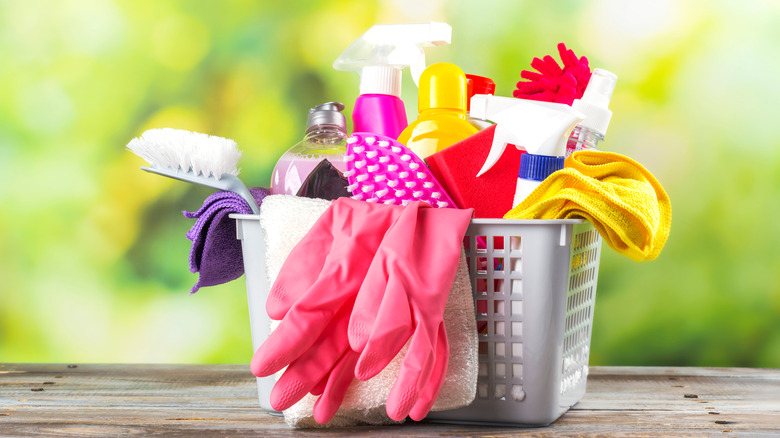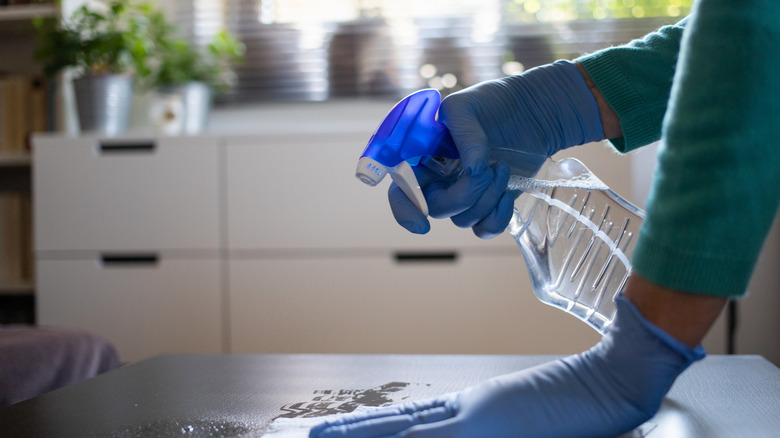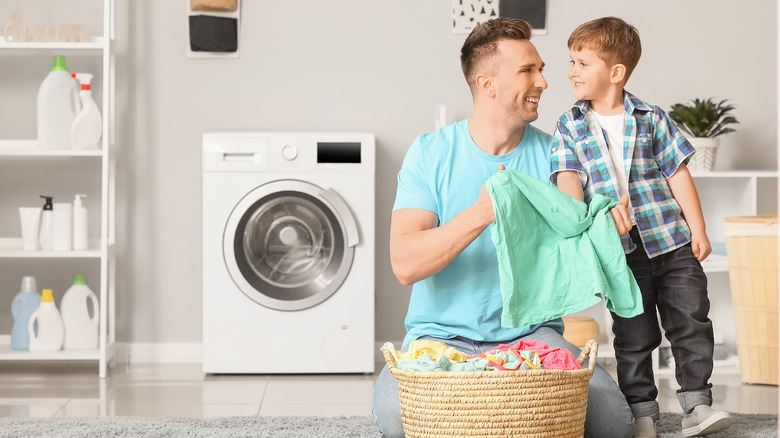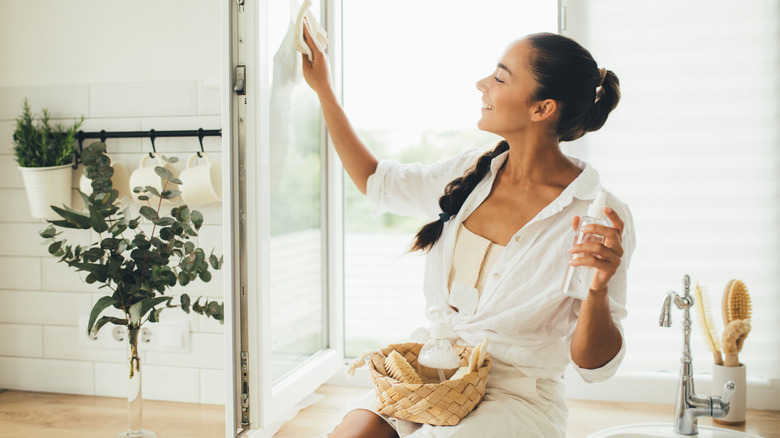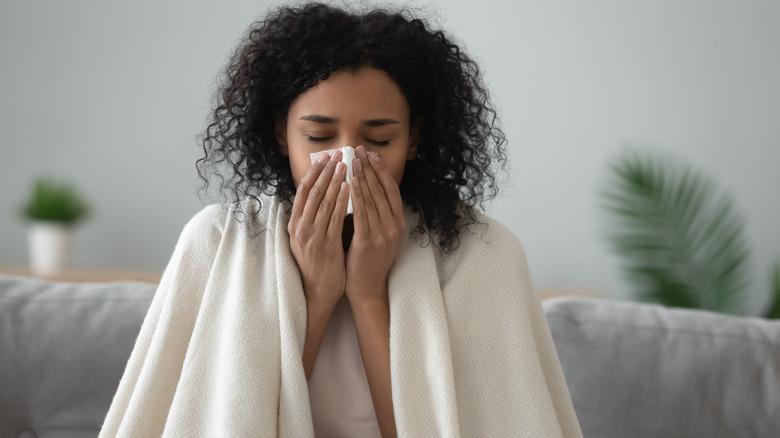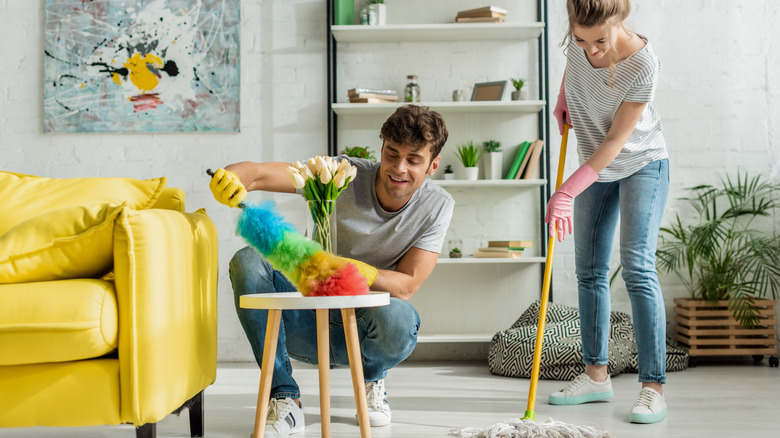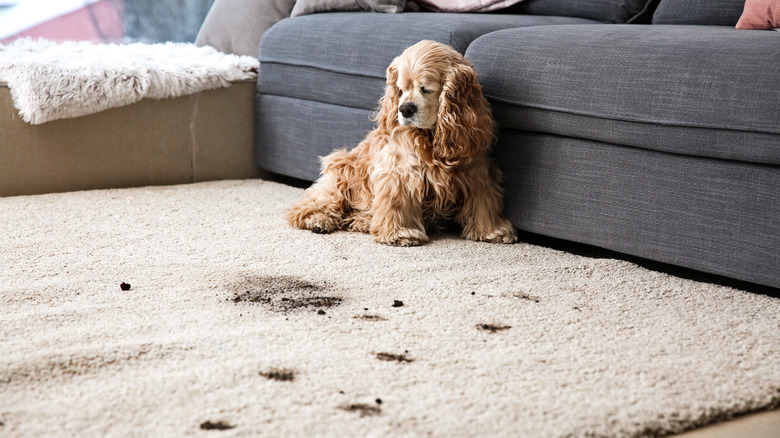Cleaning Mistakes That May Increase Your Chances Of Catching COVID-19
Could your house sparkle from floor to ceiling and still not be free of COVID-19 germs? The answer is absolutely, because when we're up against a deadly virus, the old cleaning rituals can fall short. And many people make cleaning mistakes that can allow COVID-19 germs to linger.
Today, we know that airborne particles transmitted from one person to another is the primary way coronavirus spreads. Also, you are much less likely to get COVID-19 from a virus-infected surface than to breathe it through the air. Yet, Penn Medicine points out that the Centers for Disease Control and Prevention (CDC) still recommends giving daily attention to high-touch surfaces, even if you're staying at home. The reason? Exposure becomes possible when folks enter and exit the house, says Penn Medicine, citing a study that reveals COVID-19 can live on surfaces like cardboard for 24 hours and plastic and stainless steel for three days.
Many are motivated to battle germs as they clean, and there are times when this is especially important, such as when a family member has COVID-19 or its symptoms. With lives at stake, recognizing and avoiding the following mistakes is well worth the effort.
Beating the clock while COVID-19 cleaning
This is a fast-paced world, and cleaning is not something we like to savor like a chocolate latte or a good flick. But those with experience fighting COVID-19 warn that disinfectants often must stay on a surface and soak in for at least a minute, maybe longer, to work. Yet many people have no idea of this requirement. "A lot of us give something a quick swipe and think we've disinfected it," says Natascha Tuznik, assistant clinical professor of infectious diseases at Sacramento-based UC David Health. "I don't know of any product that gets it done with just a swipe."
Some disinfectants are faster than others, but according to Tuznik, not even the best gets the job done in less than one minute. To find out how long your favorite product must sit on a surface to fight COVID-19, visit the U.S. Environmental Protection Agency's List N Tool. One of the most important questions this tool answers is whether your disinfectant even works against the virus.
Another reason why COVID-19 cleaning cannot be rushed is many disinfectants only work effectively when the surface is clean, and that often means scrubbing; no surface will go germ-free without a little effort. The CDC advises that only some disinfectants have a cleaning agent. Don't know if yours is a double threat? Check the above list to be sure.
Choosing the wrong products to clean, disinfect, or sanitize
When a soldier gears up for battle, one of their prime objectives is making sure they have the right weapons — same too with the war against COVID-19. Very often winning the war means having the right ammo — in this case a journey that begins at the supermarket and what cleaning products you put in your cart. A selection motivated by a bargain price or lemon-fresh smell may fall short in the trenches of household cleaning. While we might tend to lump these products all together, some don't fight COVID-19 at all.
In the supermarket cleaning aisle, you're likely to find an army of cleaners, sanitizers, and disinfectants. Here's the difference: Sanitizers kill bacteria on surfaces. Scratch that one off for COVID-19, a deadly virus. Cleaners, like soap or detergent and hot water, get rid of dirt and organic material, and many times are enough. Disinfectants kill viruses, and if used correctly, will mean curtains for COVID-19. Again, refer to the EPA's list of disinfectants that work best against the novel coronavirus.
If these products are not available, a diluted bleach solution can get the job done as well. Consumer Reports also gives recommendations on which products to use — and to avoid. Look for products with alcohol and other known virus busters.
Underestimating soap and water
Soap and water have been around for ages, so it's natural to wonder if they can really keep pace with modern cleaners in the war against COVID-19. However, disinfecting sprays should not replace cleaning with soap and hot water for a thorough job, explains Erick McCallum, founder of Texas-based CG Environmental. Since the products he uses to kill COVID-19 require infectious disease training, McCallum recommends soap and hot water for the average home. "That's what kills the virus," he told CNBC. Even when disinfectants are called into action, McCallum still thinks hot water should be utilized to boost the cleaning process.
Soap and water attack the virus in another rather amazing way: friction. Consumer Reports explains that scrubbing with any variety of soap and water can penetrate the protective barrier of the COVID-19 virus. "Scrub like you've got sticky stuff on the surface, and you really need to get it off," Richard Sachleben, an organic chemist, told the outlet. Either toss the towel or soak it afterward to remove lingering particles.
Indeed, all this can be accomplished by just regular soap and good old H2O. In fact, it's hard to find an article from the CDC or any health source that does not stress the value of this classic combination.
Neglecting high-touch areas that harbor germs
Think the germiest place in the house is the toilet seat? Think again. While studies have shown the toilet seat may contain on average between 50 and almost 300 bacteria per square inch, according to Forbes, the cellphone has that beat. Even before COVID-19, a University of Arizona microbiologist discovered that germs on cellphones were 10 times more numerous than those on a household toilet. And some experts say that's nothing for a mobile phone, a device that goes almost everywhere, and that we put near our face.
Now that those germs could include COVID-19, the cringe factor is amplified — but cellphones are not the only high-touch household item that people forget to clean often enough, according to UNICEF. It's bound to make any mom run for the Lysol when we think about some of the other items on the list — computers, tablets, remote controls, game controllers, and toys — and who's likely to use them. (One might also consider wipes made to protect electronics, banning gadgets from the bathroom, and washing hands before touching keyboards and the like, says Forbes.
When it comes to high-touch areas, UNICEF also reminds us of light switches, door handles, tables, chairs, handrails, taps, kitchen, and bathroom surfaces — the toilet, too. All these areas see a lot of action, and you might think of more in your own home. Even the most thorough effort will not rid the house of COVID-19 if common household areas are overlooked.
Spreading COVID-19 by wearing shoes in the house
You'd likely expect some profound advice from a former Texas cop in the business of crime-scene and now COVID-19 cleanups. But what Erick McCallum, founder of CG Environmental, most stressed about post-pandemic home cleaning in a CNBC interview smacks of something moms have been saying for decades: Take off your shoes.
If you're careful about packages and shopping bags, but wear your shoes inside, you haven't gone the extra mile to keep your home free of COVID-19. Germs are tracked onto floors, invade carpets, and can infiltrate surfaces where children play. And just think of where those shoes or sneakers may have traveled! Could germs from a doctor's office be hiding on your living-room rug? Give it enough thought, and it will make you cringe, too.
Penn State's Huck Institutes of the Life Sciences agrees that you should not wear shoes inside of the home that have been outside. Instead, remove shoes at the entrance and any COVID-19 viruses on your soles will die off. McCallum also recommends a small pan with bleach and water outside the house for the bottoms of shoes.
Failure to read the label
One thing that poison control centers have learned about many busy Americans: We don't take the time to read labels. So, it should come as no surprise that the increased use of disinfectants during COVID-19 may have led to adverse reactions.
According to Time, a team of CDC investigators traced a sharp increase in reports of poisonings from 2019 to 2020 (the study period was January through March). The spike was 12% for cleaning products and 36% for disinfectants. Inhalation of fumes accounted for many of the poisonings, and these showed a 108.8% increase relating to disinfectant use during the same period. While it cannot be said for certain that COVID-19 triggered the increase, these reports did coincide with the pandemic.
Bottom line: Read those labels, maximize your ventilation, and don't mix chemicals. Many of the poisonings included children under age 5 so take care to store chemicals out of reach.
Assuming antibacterial soap provides extra protection against COVID-19
Since scrubbing with soap and hot water can break the hold of this deadly virus, one might think that antibacterial soap will be a regular dynamo. But don't let the word antibacterial fool you into thinking this type of cleaner is a pandemic powerhouse. The reason? Antibacterial soap is formulated to be lethal against bacteria as opposed to viruses, so there's no extra benefit in this situation, says Consumer Reports. Plus, the secret is the scrubbing action of this or any soap to destroy the virus, not a special variety of soap.
After cleaning the house from top to bottom, washing your hands with antibacterial soap might seem natural — but don't overdo it, as too much antibacterial soap can work against you. "If everybody's using antibacterial soaps, you're going to actually encourage drug-resistant bacteria to develop," Dr. Dan McGee, pediatrician at Helen DeVos Children's Hospital in Grand Rapids, Michigan, told Today. "And soap and water is good."
Gloves: protection or illusion?
To really win the cleaning war against COVID-19 we need to safeguard our hands. For many that means wearing gloves, especially when cleaning. But some experts frown on gloves unless handling harsh disinfectants or caring for a coronavirus sufferer. The reason? People get overconfident with gloves and may overlook the most important step of all: a thorough hand washing. In fact, that overconfidence can cause people to mistakenly think they're protected when they aren't, potentially raising their risk of contracting COVID-19, says Penn State Huck Institutes of the Life Sciences. Additionally, Sacramento's UC Davis Health points out that there is no science proving that wearing gloves renders you more protected from the novel coronavirus.
Orlando Health agrees that gloves are not necessary for routine activities, and that they can increase your chances of getting COVID-19 if overconfident. Some obvious mistakes are reusing or rewashing them, buying a cheap variety that may leak, or failing to change them often enough. Since cleaning often involves chemicals, gloves can make sense, but never should they stand in the way of soap and water.
Not guarding against laundry blunders
Part of cleaning the house against COVID-19 is regularly washing comforters, bedding, sheets, and clothing. Additionally, heat is your friend when it comes to washing laundry to remove the threat of COVID-19. Use the warmest temperatures your clothes will allow and dry clothes thoroughly (in accordance with the label), says UNICEF. Both sources of heat are needed for maximum results.
The laundry room can be another weapon in the COVID-19 arsenal if you understand the importance of attacking germs on fabrics. While we don't know for sure for how long the novel coronavirus can live on the surface of linens and clothes, it can live up to a few days on metal and plastic that are attached to fabric. To that end, some habits that could spread COVID-19 include shaking out dirty clothes, which could launch virus particles into the air, and not washing your hands after doing laundry. For good measure, clean or disinfect the hamper or use a disposable laundry bag.
Trusting in natural cleaners against COVID-19
If your lifestyle is eco-friendly or if a family member has asthma triggered by chemicals, natural products may seem the natural choice in combating COVID-19. But while many people prefer natural products, they may not pack much punch against the novel coronavirus. Neither does tea tree oil, homemade hand sanitizer, or vodka, says Consumer Reports. (Save the vodka for your martini when cleanup is over.)
One popular cleaning combo — vinegar and baking soda — also lacks the oomph to kill the virus, according to Eric Jr. Beckman of the University of Pittsburgh Engineering Department. "Viruses are robust creatives," he explained to The Philadelphia Inquirer. Indeed, this green team is likely to only change the pH.
According to The Washington Post, citric acid and alcohol are two "safer" choices that could beat the virus, and there may be others as well, but nowhere near the bounty of chemical-based disinfectants on the EPA's list of effective COVID-19 cleaners.
Not changing your cleanup routine when needed
COVID-19 is bad enough without it spreading throughout your household. Ideally the person with COVID-19 or symptoms would be isolated and able to clean and disinfect their own rooms as well as any shared spaces after use. Failure to clean germ magnets like faucets and counters three times a day can add to the spread.
When it's necessary to clean and disinfect for a family member with COVID-19 or its symptoms, the CDC recommends caution. Limit your exposure by only targeting visibly soiled areas in the quarantine area and then only with masks and plenty of ventilation. Gloves may be needed for your cleaning or disinfectant products, and certainly when washing the sick person's dishes in soap and hot water (the dishwasher works too). But wash those hands like you mean it. Cleanups should be done more frequently when a family member is at high risk.
Starting your COVID-19 cleanup with dirty supplies
Even the workhorses of our cleanup effort need attention now and then, especially when enlisted in the fight against COVID-19. Neglecting sponges, dust mops, brooms, and other cleaning supplies is a common mistake and one that can be remedied with a little effort.
According to The Spruce, mop heads all need to be cleaned — they pick up just about everything Fido brings in from the yard. It can be as simple as tossing a removable cotton and microfiber mop head in a washing machine with heavy-detergent and hot water. For a sponge mop head, try soaking it in hot water and bleach, while for nonremovable fabric mop heads, a gallon of hot water with 2 tablespoons of a pine cleaner or detergent does the trick.
Another workhorse, the broom, can shake its dirt with a good soak in 2 teaspoons of dishwashing liquid and hot water. Give it a cold-water rinse then hang to dry. Sponges should be disinfected weekly in a bleach-hot water mix, but dusters need to be cleaned after each use in dishwashing liquid and warm water.
Forgetting the dirty truth about carpets, rugs and other soft surfaces
Like cellphones, the average carpet can hide an alarming host of bacteria — from salmonella to E. coli, and now COVID-19 as well. More grotesque than even your toilet seat, carpet can harbor 200,000 bacteria per square inch, says Dr. Philip Tierno, a microbiologist at NYU Langone Medical Center, to Bob Vila.
Now there's your motivation to break out the vacuum and shampoo or steam the rugs more often — especially if the kids are still forgetting to take shoes off at the door. (The CDC recommends wearing a mask when vacuuming in a household where someone has COVID-19 or its symptoms.) "Also, it seems nearly impossible to really deep clean and sanitize carpet in a home environment and, with an increasing need for sanitation and cleanliness, many people feel that carpets are dirty," Pamela O'Brien, principal designer for Pamela Hope Designs, told Apartment Therapy. For some who still like the soft feel of carpet between their toes, the solution may be the washable rugs that are trending in today's germ-conscious society, notes NBC News.
With the pandemic still a deadly threat, it's time to break old habits if they are letting COVID-19 survive in our homes. Even a few hours or days is enough time for this global killer to pose a danger to our family. Follow one or more of these bash-the-virus recommendations and you will be in a better position to stop the spread.
